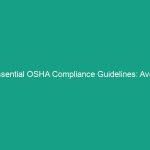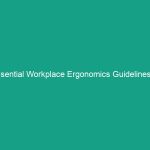Introduction
Good morning team! Today, we’re going to talk about a crucial aspect of our daily work: Essential Guidelines to Avoid Unsafe Acts and Enhance Workplace Safety. Safety is not just a priority; it’s a responsibility we all share. Understanding and implementing these guidelines can significantly reduce the risk of accidents and injuries in our workplace. So, let’s dive in and explore how we can work together to promote a safer Environment for everyone.
Understanding Essential Guidelines to Avoid Unsafe Acts
The phrase “Essential Guidelines to Avoid Unsafe Acts” refers to a set of protocols and Best Practices designed to mitigate risks and enhance Safety in the workplace. These guidelines are vital as they help prevent accidents that can lead to injuries, loss of productivity, and even legal repercussions for the company. Adopting these practices not only safeguards your well-being but also fosters a culture of Safety and accountability within our team.
One common misconception is that Safety Guidelines are merely suggestions. In reality, they are essential rules that must be followed to ensure a safe working environment. Ignoring these guidelines can have severe consequences, including workplace injuries that affect not only the injured party but also their colleagues and the overall workplace atmosphere.
Key Hazards, Risks, and Safety Considerations
In our work environment, there are various Hazards that can lead to unsafe acts. Here are some common risks to be aware of:
- Slips, Trips, and Falls: These incidents can happen due to wet floors, uneven surfaces, or cluttered walkways.
- Improper Use of Equipment: Using tools or machinery without following safety protocols can lead to serious injuries.
- Inadequate Personal Protective Equipment (PPE): Failing to wear appropriate Safety Gear can expose you to harmful substances or accidents.
- Poor Ergonomics: Incorrect posture or lifting techniques can lead to musculoskeletal disorders.
Ignoring these hazards can lead to serious consequences, such as workplace injuries that could have been easily prevented. For instance, a slip on a wet floor can result in broken bones or sprains, affecting your ability to perform your job and potentially leading to long-term health issues.
Best Practices, Procedures, & Actionable Advice
Now that we understand the risks, let’s discuss some Best Practices to enhance Workplace Safety:
- Follow Safety Protocols: Always adhere to established safety guidelines and Procedures. Familiarize yourself with the safety manual and participate in safety Training sessions.
- Report Hazards: If you notice a potential hazard, report it immediately to your supervisor. Early detection can prevent accidents.
- Use PPE Correctly: Always wear the required Personal Protective Equipment for your tasks. This may include gloves, helmets, goggles, or hearing protection.
- Keep Work Areas Clean: Maintain a tidy workspace to minimize tripping hazards. Ensure that tools are stored properly and that spills are cleaned up promptly.
- Practice Safe Lifting Techniques: When lifting heavy objects, use your legs rather than your back. Keep the load close to your body and avoid twisting while lifting.
For example, a colleague once ignored safety protocols while operating a piece of machinery. The result was an accident that not only injured them but also halted production for several days. This serves as a powerful reminder of how essential it is to follow safety guidelines diligently.
Regulations, Standards, and Compliance
Compliance with safety Regulations is not optional; it’s essential. The Occupational Safety and Health Administration (OSHA) sets forth guidelines that protect workers and ensure safe working conditions. Adhering to these regulations not only safeguards you but also protects the company from potential fines and legal issues.
Additionally, our organization has specific safety Standards that align with osha regulations. Understanding and following these protocols is critical. This includes participating in safety training, attending safety meetings, and keeping updated with any changes in safety policies.
Employee Engagement & Discussion
Let’s take a moment to think about our own experiences. Have you encountered any safety challenges related to the protocols we’ve discussed today? What strategies have you implemented to ensure your safety and the safety of your colleagues? Engaging in these discussions can lead to deeper insights and improvements in our safety practices.
Conclusion & Key Takeaways
In conclusion, adhering to the Essential Guidelines to Avoid Unsafe Acts and Enhance Workplace Safety is crucial for protecting ourselves and our colleagues. Remember, safety is a shared responsibility that requires constant vigilance and commitment. By following the best practices we’ve discussed, we can create a safer workplace for everyone.
Thank you all for your attention and for your ongoing commitment to safety. Let’s prioritize safety today and every day!


